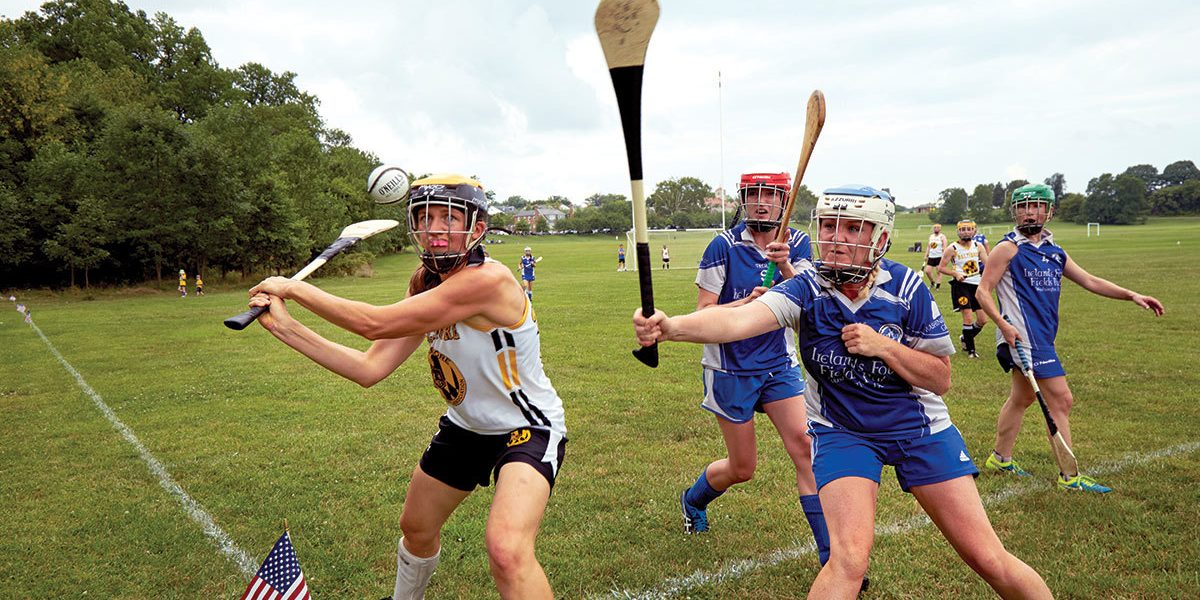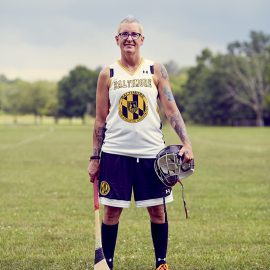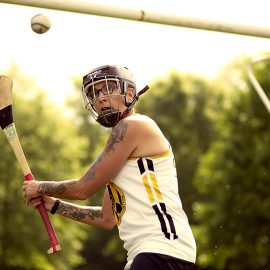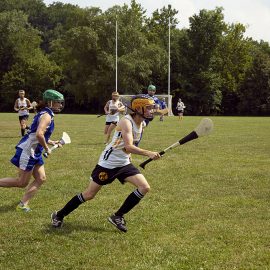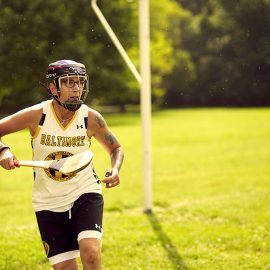News & Community
You Are Here: Home Game
Scenes from the Gaelic Assocation's camogie game, Born in Baltimore film festival, and Gamescape.
Home Game
July 15, 2017
Herring Run Park
With the game still scoreless after a dozen minutes, Fiona Guinan snatches a baseball-sized white sphere skittering across the grassy field with her bare hand. She quickly tosses it a few inches above her waist, and then, in a single motion, like a right-handed Chris Davis, but on the run, swings her open-faced wooden stick and bashes a long, rising fly ball through the uprights for the game’s first tally. Minutes later, Guinan does it again—this time from 35 yards away—and suddenly, the Baltimore Gaelic Athletic Association’s camogie team and their Irish ringer are on their way to an easy win over their Washington, D.C., rivals. “I’ve been playing since I was six,” Guinan, the visiting 21-year-old Dublin college intern, says with a smile afterward.
The women’s version of the ancient Emerald Island game known as hurling, camogie is akin to a smash-up of lacrosse and field hockey, but with both soccer-like goals and American football uprights for scoring. The game’s roots, explains Isadore Beattie, the sixtysomething Irish coach of the Baltimore squad, date back several thousand years to when villages settled scores with daylong matches. “The annual All-Ireland Hurling Championship is bigger than the Super Bowl,” he explains. “The whole county goes to watch if their team makes the final. You won’t find a dog in the street that day.”
The Baltimore club was formed in 2003 by Lucy Prendeville, who was inspired to take up the game after visiting her ailing Irish grandmother. “She told me to forget field hockey and start playing camogie,” Prendeville says. “So I did. I guess I was anxious to connect to my Irish heritage.”
“She’s 40 and runs around like a teenager out there,” marvels her Ireland-born husband Tadgh, who has retired to the sidelines. “She hasn’t said it as such, but I think she intends to keep playing until our 7-year-old, Patricia, is ready to carry on.”
Prendeville’s daughter, however, will likely have help keeping the Gaelic sporting tradition alive here for another generation.
“So far, there have been four marriages, another is in the works, between the men’s and women’s teams, with nine children altogether,” Prendeville says. “That would definitely make my grandmother happy.”
Home Spun
July 15, 2017
Eastern Avenue
As the dreadlocked, pierced, and skirt-wearing Coffin Nachtmahr picks his way through the buffet at the Creative Alliance, awaiting the results of the first-ever Born in Baltimore film festival, a lanky teenager approaches with a question: “How did you do that?”
As if on cue, Nachtmahr pulls a yo-yo from his pocket and begins to gently dance what’s known as “the stack” back and forth on a string between his chest-high hands. “I’ll show you,” Nachtmahr responds, turning for his backpack. “I’ve got another one with me.”
A Mid-Atlantic champ and national yo-yo competitor, Nachtmahr—a nom de guerre used by the 25-year-old East Baltimore native—is the star of the documentary Throw that screened here this afternoon. “I wasn’t like all the rest of the kids. People would pick on me just for being me,” says Nachtmahr in the 10-minute film’s opening as he looks into a mirror and applies make-up across the bridge of his nose and around his eyes. “‘This kid is weird. He stutters. He’s probably like a retard or something.’”
Not surprisingly, the film, which recently won a regional Emmy, wins the judge’s nonfiction and audience awards.
Throwing his yo-yo behind his back, twirling it around his fingers and neck, Nachtmahr makes the seemingly simple novelty toy sing in a way that is startling—“like a whimsical high-wire artist,” says David Larson, who spotted him playing one day while walking through Patterson Park and made the film with Early Light Media partner Darren Durlach.
Nachtmahr, who works as a handyman part-time, also plays guitar and makes art, juggles, skateboards, and passes time with a Japanese cup-and-ball game called Kendam. But none of it does what the yo-yo does for him.
“There’s always music in my mind when I yo-yo and, together, that puts me in a certain headspace that helps me just ‘be’ day to day,” Nachtmahr explains. “I can’t explain it. I can’t really function without it.”
Kill Joy
July 21, 2017
Maryland Avenue
“Who would like this game?” a twentysomething man with dyed blonde hair asks Cole Pritchard, co-inventor of “Mister Mart,” a virtual reality game in which a retail clerk at a badly run store punches annoying customers trying to return their purchases. (Players rack up points by successfully refunding merchandise, and relieve “stress” by smacking customers and hitting them with store items.)
“Anybody who likes violence,” Pritchard deadpans.
In fact, there has been a line to play Mister Mart—which began as Pritchard and Karen Chang’s thesis project at the Maryland Institute College of Art three years ago—since the opening of the Gamescape pavilion at Artscape. Set to launch via Steam, the online gaming platform, Mister Mart is one of two dozen indie, professional, and throwback games available for play at Gamescape.
“The old-school Nintendo games like Mario Kart and Super Smash Bros. are popular,” says Ben Walsh, who founded Gamescape in 2010 and is the owner of the Highlandtown-based company Pure Bang Games. “But it’s great to see independent games getting so much interest.”
Another popular, still-in-development indie game is “Rock, Paper, Scissors,” which brings the basics of the classic contest into a fast-paced, multi-player gaming space where all three competitors try at once to “prey” upon their various targets—paper for scissors, for example—while scurrying away from their own predator.
For game makers, the tweaking process takes years, with Gamescape proving valuable, real-time user feedback. Some, like Pritchard and Chang, have brought their games back more than once for public pleasure and scrutiny.
“I love it,” says 8-year-old Jackson Limmer after pulling his Oculus virtual reality headgear off, following a long turn bashing Mister Mart virtual customers. “It’s better since last year, too. You can see everything better,” he says. “Last year, I punched a real person by mistake.”
